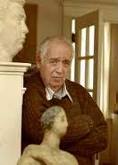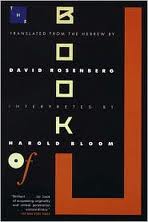 She lived in Jerusalem almost 3,000 years ago, in the time of King Solomon and his hapless son and successor, Rehoboam. A contemporary of the historian who chronicled Solomon’s court, she wrote in the Phoenician-Old Hebrew script, probably using a reed pen on sheets of papyrus that were later glued into scrolls. Known to modern biblical scholars only as J, she was one of history’s great writers, comparable in imaginative and rhetorical scope to Homer, Dante, Chaucer, Shakespeare, Cervantes and Tolstoy.
She lived in Jerusalem almost 3,000 years ago, in the time of King Solomon and his hapless son and successor, Rehoboam. A contemporary of the historian who chronicled Solomon’s court, she wrote in the Phoenician-Old Hebrew script, probably using a reed pen on sheets of papyrus that were later glued into scrolls. Known to modern biblical scholars only as J, she was one of history’s great writers, comparable in imaginative and rhetorical scope to Homer, Dante, Chaucer, Shakespeare, Cervantes and Tolstoy.
Or so asserts American literary critic Harold Bloom in his study The Book of J (1990), which contains a stark translation by David Rosenberg of J’s reconstructed text. With breathtaking insight and fancy, Bloom embellishes the secular theory that the Torah had multiple authors and redactors (identified as J, E, P, D and so on) by presenting a literary interpretation of J that opens with the startling proclamation that this greatest of Jewish writers was a woman.
It was in the 19th century that German exegetes first noted various pronounced stylistic differences in the Pentateuch, and assigned authorship passage by passage to an alphabet soup of imagined authors. Although it contradicts the normative Jewish tradition that the Torah was handed down at Sinai, some Jewish thinkers, including Bloom, have furthered this conception of the Torah as a brilliant literary patchwork quilt stitched together over centuries.
Purportedly the author of much of Genesis and Exodus, J is defined by her consistent use of the Tetragrammatonic name of God and by her bold dramatic irony and supreme narrative inventiveness. According to Bloom, J wasn’t attempting to compose a sacred text when she reworked age-old legends about the Creation, the Flood, the Patriarchs, Joseph and Moses. Highly erudite and sophisticated, she was a product of the Solomonic enlightenment whose works were censored, revised and abrogated by a series of later hands. To understand her works, Bloom insists, one must first strip away the heavy varnish that overlays them.
Characterizing J as possessing a Shakespearean narrative ingenuity and an ironic outlook worthy of Kafka, Bloom assesses each of her literary creations, from Adam and Eve through the Patriarchs, Joseph and Moses, boldly culminating with J’s depiction of God. Unperturbed that this approach contravenes the Maimonidean precept that God is essentially unknowable and indescribable, Bloom sees in J’s humanistic conception of God an impish child who fashions the first man from the dirt as though shaping mudpies, and who capriciously, possessively, digs a grave for Moses with his own hands at a spot that no one shall ever find.
 J has no villains or heroes, Bloom says, only heroines such as Tamar, Rebeccah and Rachel, each of whom outsmarts a man for her own shrewd end. In Bloom’s eyes, J has no overriding reverence or awe for either the Patriarchs or the God that was her literary creation. Of all her characters, she supposedly shows the greatest feeling for Joseph, who was for her a surrogate for David; both are highly charismatic, charmed figures who win glory for Israel. Having seen the fragmentation of the Kingdom under Rehoboam, J supposedly yearned for a return to that past glory.
J has no villains or heroes, Bloom says, only heroines such as Tamar, Rebeccah and Rachel, each of whom outsmarts a man for her own shrewd end. In Bloom’s eyes, J has no overriding reverence or awe for either the Patriarchs or the God that was her literary creation. Of all her characters, she supposedly shows the greatest feeling for Joseph, who was for her a surrogate for David; both are highly charismatic, charmed figures who win glory for Israel. Having seen the fragmentation of the Kingdom under Rehoboam, J supposedly yearned for a return to that past glory.
J was most conversant with the history of Solomon’s court and not of remote events like the Exodus, Bloom notes. “Since I date J in the generation after Solomon, who died in 922 BCE, she was writing of events a full three centuries before her own time, or about as far back as the Cromwellian revolution in relation to current Great Britain,” he writes. “… David’s old age was perhaps half a century before J wrote; he was as close to her as Winston Churchill and Franklin Delano Roosevelt are to many among us. …”
In his most recent work, The Western Canon: The Books and Schools of The Ages, Bloom categorizes the 26 most important books of Western literature into four categories — Theocratic, Aristocratic, Democratic and Chaotic. Not surprisingly, he elaborates on his caricature of J by suggesting that she was actually Bathsheba, the Hittite woman taken by David who became Solomon’s mother. This, he argues, would explain J’s “ironic presentation of the Hebrew patriarchs, and her fondness both for some of their wives and for such female outsiders as Hagar and Tamar.”
Superbly ironic and audacious, Bloom’s interpretation seems entirely in keeping with the J that he has fashioned for us. Whether he has overstepped our willing suspension of disbelief is immaterial. What matters is the refreshing boldness and originality of his insight, and his formidable challenge to us to see these very old subjects in a very new way. ♦
© 1996






